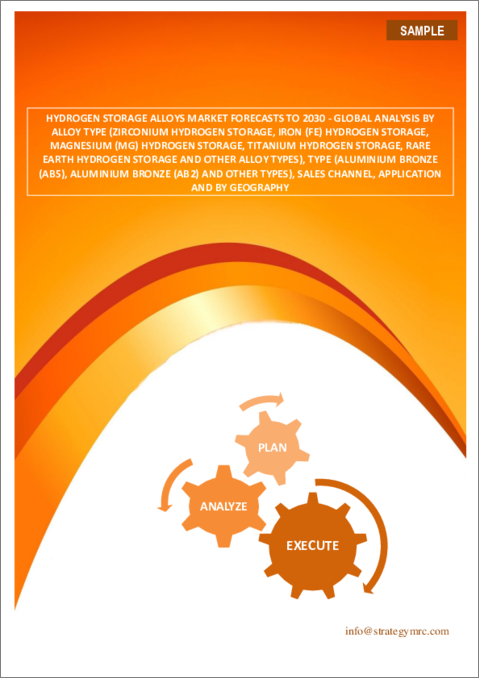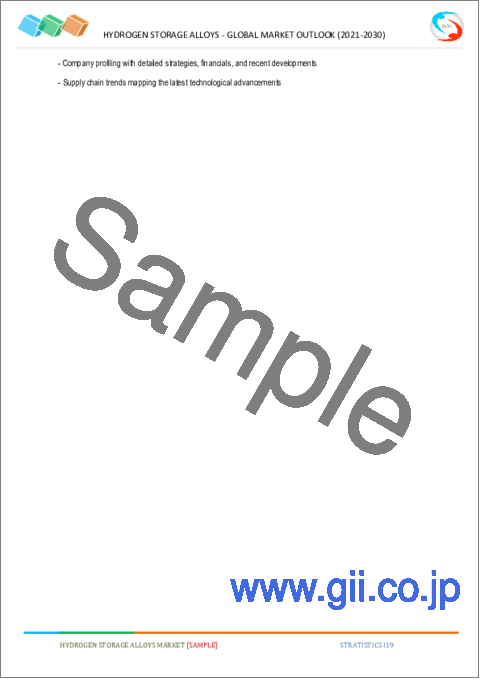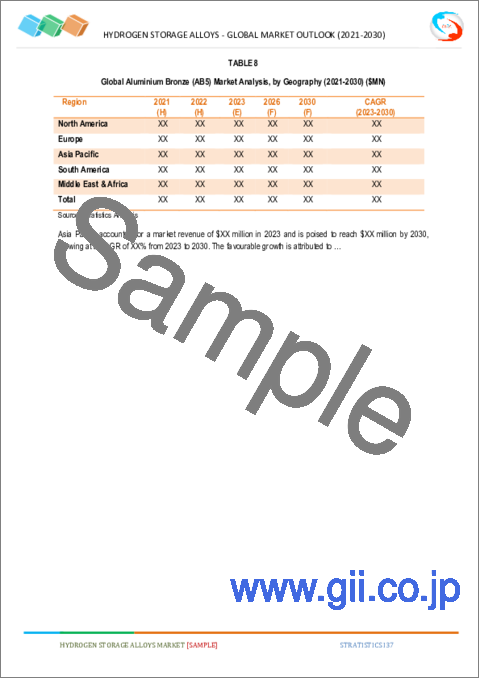|
|
市場調査レポート
商品コード
1503376
水素吸蔵合金市場の2030年までの予測: タイプ別、貯蔵容量別、販売チャネル別、技術別、用途別、地域別の世界分析Hydrogen Storage Alloys Market Forecasts to 2030 - Global Analysis By Type (Metal Hydrides, Complex Hydrides, Intermetallic Compounds, Chemical Hydrides and Other Types), Storage Capacity, Sales Channel, Technology, Application and By Geography |
||||||
カスタマイズ可能
|
|||||||
| 水素吸蔵合金市場の2030年までの予測: タイプ別、貯蔵容量別、販売チャネル別、技術別、用途別、地域別の世界分析 |
|
出版日: 2024年06月06日
発行: Stratistics Market Research Consulting
ページ情報: 英文 200+ Pages
納期: 2~3営業日
|
全表示
- 概要
- 図表
- 目次
Stratistics MRCによると、水素吸蔵合金の世界市場は2024年に35億4,000万米ドルを占め、予測期間中のCAGRは7.8%で、2030年には52億1,000万米ドルに達する見込みです。
水素吸蔵合金は、可逆的な化学反応によって水素ガスを吸収・放出できる材料です。これらの合金は、ニッケル、チタン、希土類元素などの金属で構成されることが多く、水素を吸収すると金属水素化物を形成します。その主な用途は水素貯蔵システムであり、燃料電池やエネルギー貯蔵を含む様々な用途のために水素を貯蔵する安全で効率的な手段を提供します。これらの合金は、高い貯蔵容量、安定性、特定の条件下で制御可能な速度で水素を放出する能力が評価されています。
国際エネルギー機関(IEA)によると、電気分解メカニズムによって製造される水素は、将来的に大きな可能性を秘め、安価な燃料として大きな期待が寄せられています。
クリーンエネルギーへの需要の高まり
水素吸蔵合金は、クリーン・エネルギー・キャリアである水素を貯蔵し、燃料電池やその他の用途に利用する上で重要な役割を果たします。産業界や政府が二酸化炭素排出量を削減するために再生可能エネルギー源にシフトするにつれて、水素貯蔵技術に対する需要が高まっています。このため、水素吸蔵合金の進歩や投資が促進され、効率、容量、費用対効果が向上し、市場成長が促進されます。
インフラの限界
水素充填ステーションの不足などのインフラの制約は、水素吸蔵合金市場に大きな課題を突きつけています。限られたインフラが水素燃料電池車の普及を妨げ、水素吸蔵合金の需要を制限しています。加えて、水素補給インフラの確立に関連する高コストが投資と普及を阻害し、市場成長を鈍化させています。
自動車分野での採用増加
水素合金は、自動車の運転に不可欠な燃料電池において、水素を効率的に貯蔵・放出するために不可欠です。環境に優しい輸送ソリューションへの需要が高まるにつれ、自動車メーカーは水素燃料電池技術への投資を増やしています。このため、高度な水素貯蔵ソリューションの必要性が高まり、水素吸蔵合金市場が活性化しています。二酸化炭素排出量削減への関心の高まりが、この成長動向をさらに加速させています。
代替技術との競合
圧縮水素ガスや炭素系材料のような代替技術との競合が、水素吸蔵合金市場に課題を突きつけています。圧縮水素はよりシンプルなインフラと低コストを提供し、炭素系材料はより高い貯蔵容量を約束します。これらの代替技術は、より費用対効果が高い、あるいは技術的に進んでいると思われる競合市場競争力のある貯蔵ソリューションを提供することで合金市場を阻害し、投資や研究を水素吸蔵合金からそらす可能性があります。
COVID-19の影響
COVID-19の流行は、サプライチェーンの中断、主要産業からの需要の減少、プロジェクトの遅延により、水素吸蔵合金市場を混乱させました。このような挫折にもかかわらず、持続可能な開発と二酸化炭素排出量削減への世界の重点が拍車をかけ、クリーン・エネルギーと水素技術への投資が増加し、市場は回復に向かっています。グリーンエネルギーへのパンデミック後の注目は、この分野の長期的成長を促進すると予想されます。
予測期間中、複合水素化物セグメントが最大になる見込み
複合水素化物セグメントは有利な成長を遂げると推定されます。複合水素化物は、高い水素貯蔵容量を可能にする複雑な分子構造を特徴とする水素吸蔵合金の一種です。アラネートや水素化ホウ素のような材料が含まれ、適度な温度と圧力で水素を貯蔵・放出する能力で知られています。複合水素化物は、持続可能なエネルギー技術の発展を目指す燃料電池自動車や携帯電子機器など、コンパクトで効率的な水素貯蔵ソリューションを必要とする用途に有望です。
予測期間中、化学吸収技術分野のCAGRが最も高くなると予想されます。
化学吸収技術セグメントは、予測期間中に最も速いCAGR成長が見込まれます。水素吸蔵合金の化学吸収技術は、水素を吸収・放出する可逆的な化学反応を伴う。このプロセスは通常、金属水素化物のような材料を利用し、特定の条件下で水素を吸収し、条件が変わると放出します。水素を安全かつ高密度に貯蔵する効率的な方法であり、燃料電池、ポータブル電子機器、信頼性の高い水素供給・流通を求めるエネルギー貯蔵システムなどの用途に不可欠です。
最大のシェアを占める地域:
アジア太平洋地域の水素吸蔵合金市場は、再生可能エネルギーと水素燃料技術への投資の増加により、著しい成長を遂げています。日本、韓国、中国のような国々が、新興経済諸国の発展を目指した政府の実質的な支援と産業イニシアティブで主導しています。日本の「水素基本戦略」や韓国の水素ロードマップは、こうした取り組みの一例です。さらに、自動車セクターの水素燃料電池車へのシフトとエネルギー貯蔵技術の進歩が、この地域の市場拡大をさらに後押ししています。
CAGRが最も高い地域:
北米の水素吸蔵合金市場は、クリーンエネルギー・ソリューションへの投資拡大と水素インフラ整備によって力強い成長を遂げています。米国とカナダがその最前線にあり、水素貯蔵と燃料電池技術を支援する政府と民間セクターのイニシアティブが充実しています。米国エネルギー省は、エネルギー自立と二酸化炭素排出量削減の重要な要素として水素に注目しており、この動向は強調されています。さらに、業界リーダーと研究機関のコラボレーションが水素貯蔵材料の進歩を促進し、市場の見通しを高めています。
無料のカスタマイズサービス
本レポートをご購読のお客様には、以下の無料カスタマイズオプションのいずれかをご利用いただけます:
- 企業プロファイル
- 追加市場プレイヤーの包括的プロファイリング(3社まで)
- 主要企業のSWOT分析(3社まで)
- 地域セグメンテーション
- 顧客の関心に応じた主要国の市場推計・予測・CAGR(注:フィージビリティチェックによる)
- 競合ベンチマーキング
- 製品ポートフォリオ、地理的プレゼンス、戦略的提携に基づく主要企業のベンチマーキング
目次
第1章 エグゼクティブサマリー
第2章 序文
- 概要
- ステークホルダー
- 調査範囲
- 調査手法
- データマイニング
- データ分析
- データ検証
- 調査アプローチ
- 調査情報源
- 1次調査情報源
- 2次調査情報源
- 前提条件
第3章 市場動向分析
- 促進要因
- 抑制要因
- 機会
- 脅威
- 技術分析
- 用途分析
- 新興市場
- COVID-19の影響
第4章 ポーターのファイブフォース分析
- 供給企業の交渉力
- 買い手の交渉力
- 代替品の脅威
- 新規参入業者の脅威
- 競争企業間の敵対関係
第5章 世界の水素吸蔵合金市場:タイプ別
- 金属水素化物
- 複合水素化物
- 金属間化合物
- 化学水素化物
- その他のタイプ
第6章 世界の水素吸蔵合金市場:貯蔵容量別
- 低容量合金
- 中容量合金
- 高容量合金
第7章 世界の水素吸蔵合金市場:販売チャネル別
- 直接販売
- 販売業者/卸売業者
- オンライン小売
- サードパーティのオンラインプラットフォーム
- その他の販売チャネル
第8章 世界の水素吸蔵合金市場:技術別
- 水素化物技術
- 物理吸着技術
- 化学吸収技術
第9章 世界の水素吸蔵合金市場:用途別
- 輸送機関
- 医療
- エレクトロニクス
- 産業用途
- 再生可能エネルギー貯蔵
- その他の用途
第10章 世界の水素吸蔵合金市場:地域別
- 北米
- 米国
- カナダ
- メキシコ
- 欧州
- ドイツ
- 英国
- イタリア
- フランス
- スペイン
- その他欧州
- アジア太平洋地域
- 日本
- 中国
- インド
- オーストラリア
- ニュージーランド
- 韓国
- その他アジア太平洋地域
- 南米
- アルゼンチン
- ブラジル
- チリ
- その他南米
- 中東・アフリカ
- サウジアラビア
- アラブ首長国連邦
- カタール
- 南アフリカ
- その他中東とアフリカ
第11章 主な発展
- 契約、パートナーシップ、コラボレーション、合弁事業
- 買収と合併
- 新製品発売
- 事業拡大
- その他の主要戦略
第12章 企業プロファイリング
- BASF SE
- AMETEK Specialty Metal Products
- Mitsui Kinzoku ACT Corporation
- Linde PLC
- ESG Edelmetall-Service GmbH & Co. KG
- Hitachi Corporation
- Hydrogenious LOHC Technologies GmbH
- ICL-Industrial Commodity Holdings
- INFINIUM Metals
- Magnesium Elektron Limited
- Materion Corporation
- Air Liquide S.A
- China Rare Metal Material Corporation
- Neo Performance Materials Inc.
- Sandvik Materials Technology
- ABSCO Limited
- Hydrexia Energy Technology
- LAVO System
List of Tables
- Table 1 Global Hydrogen Storage Alloys Market Outlook, By Region (2022-2030) ($MN)
- Table 2 Global Hydrogen Storage Alloys Market Outlook, By Type (2022-2030) ($MN)
- Table 3 Global Hydrogen Storage Alloys Market Outlook, By Metal Hydrides (2022-2030) ($MN)
- Table 4 Global Hydrogen Storage Alloys Market Outlook, By Complex Hydrides (2022-2030) ($MN)
- Table 5 Global Hydrogen Storage Alloys Market Outlook, By Intermetallic Compounds (2022-2030) ($MN)
- Table 6 Global Hydrogen Storage Alloys Market Outlook, By Chemical Hydrides (2022-2030) ($MN)
- Table 7 Global Hydrogen Storage Alloys Market Outlook, By Other Types (2022-2030) ($MN)
- Table 8 Global Hydrogen Storage Alloys Market Outlook, By Storage Capacity (2022-2030) ($MN)
- Table 9 Global Hydrogen Storage Alloys Market Outlook, By Low Capacity Alloys (2022-2030) ($MN)
- Table 10 Global Hydrogen Storage Alloys Market Outlook, By Medium Capacity Alloys (2022-2030) ($MN)
- Table 11 Global Hydrogen Storage Alloys Market Outlook, By High Capacity Alloys (2022-2030) ($MN)
- Table 12 Global Hydrogen Storage Alloys Market Outlook, By Sales Channel (2022-2030) ($MN)
- Table 13 Global Hydrogen Storage Alloys Market Outlook, By Direct Sales (2022-2030) ($MN)
- Table 14 Global Hydrogen Storage Alloys Market Outlook, By Distributors/Wholesalers (2022-2030) ($MN)
- Table 15 Global Hydrogen Storage Alloys Market Outlook, By Online Retail (2022-2030) ($MN)
- Table 16 Global Hydrogen Storage Alloys Market Outlook, By Third-party Online Platforms (2022-2030) ($MN)
- Table 17 Global Hydrogen Storage Alloys Market Outlook, By Other Sales Channels (2022-2030) ($MN)
- Table 18 Global Hydrogen Storage Alloys Market Outlook, By Technology (2022-2030) ($MN)
- Table 19 Global Hydrogen Storage Alloys Market Outlook, By Hydride Technology (2022-2030) ($MN)
- Table 20 Global Hydrogen Storage Alloys Market Outlook, By Physical Adsorption Technology (2022-2030) ($MN)
- Table 21 Global Hydrogen Storage Alloys Market Outlook, By Chemical Absorption Technology (2022-2030) ($MN)
- Table 22 Global Hydrogen Storage Alloys Market Outlook, By Application (2022-2030) ($MN)
- Table 23 Global Hydrogen Storage Alloys Market Outlook, By Transportation (2022-2030) ($MN)
- Table 24 Global Hydrogen Storage Alloys Market Outlook, By Medical (2022-2030) ($MN)
- Table 25 Global Hydrogen Storage Alloys Market Outlook, By Electronics (2022-2030) ($MN)
- Table 26 Global Hydrogen Storage Alloys Market Outlook, By Industrial Applications (2022-2030) ($MN)
- Table 27 Global Hydrogen Storage Alloys Market Outlook, By Renewable Energy Storage (2022-2030) ($MN)
- Table 28 Global Hydrogen Storage Alloys Market Outlook, By Other Applications (2022-2030) ($MN)
Note: Tables for North America, Europe, APAC, South America, and Middle East & Africa Regions are also represented in the same manner as above.
According to Stratistics MRC, the Global Hydrogen Storage Alloys Market is accounted for $3.54 billion in 2024 and is expected to reach $5.21 billion by 2030 growing at a CAGR of 7.8% during the forecast period. Hydrogen storage alloys are materials that can absorb and release hydrogen gas through reversible chemical reactions. These alloys, often composed of metals such as nickel, titanium, or rare earth elements, form metal hydrides when they absorb hydrogen. Their primary use is in hydrogen storage systems, providing a safe, efficient means to store hydrogen for various applications, including fuel cells and energy storage. These alloys are valued for their high storage capacity, stability, and ability to release hydrogen at controllable rates under specific conditions.
According to the International Energy Agency, hydrogen produced via an electrolysis mechanism offers enormous potential for the future and shows great promise as a cheap fuel option.
Market Dynamics:
Driver:
Growing demand for clean energy
Hydrogen storage alloys play a critical role in storing hydrogen, a clean energy carrier, for later use in fuel cells and other applications. As industries and governments shift towards renewable energy sources to reduce carbon emissions, the demand for hydrogen storage technologies rises. This drives advancements and investments in hydrogen storage alloys, enhancing their efficiency, capacity, and cost-effectiveness, thereby boosting market growth.
Restraint:
Infrastructure limitations
Infrastructure limitations such as the scarcity of hydrogen refuelling stations pose a significant challenge to the hydrogen storage alloys market. Limited infrastructure hampers the widespread adoption of hydrogen fuel cell vehicles, restricting the demand for these alloys. Additionally, the high cost associated with establishing hydrogen refuelling infrastructure deters investment and adoption, thereby slowing down market growth.
Opportunity:
Rising adoption in automotive sector
Hydrogen alloys are essential for efficiently storing and releasing hydrogen in fuel cells, which are crucial for vehicle operation. As the demand for eco-friendly transportation solutions increases, automakers are investing more in hydrogen fuel cell technology. This drives the need for advanced hydrogen storage solutions, thus boosting the market for hydrogen storage alloys. Enhanced focus on reducing carbon emissions further accelerates this growth trend.
Threat:
Competition from alternative technologies
Competition from alternative technologies like compressed hydrogen gas and carbon-based materials pose a challenge to the hydrogen storage alloys market. Compressed hydrogen offers a simpler infrastructure and lower costs, while carbon-based materials promise higher storage capacities. These alternatives hamper the alloys market by providing competitive storage solutions that may be perceived as more cost-effective or technologically advanced, potentially diverting investment and research away from hydrogen storage alloys.
Covid-19 Impact
The covid-19 pandemic disrupted the hydrogen storage alloys market due to supply chain interruptions, decreased demand from key industries, and delayed projects. Despite these setbacks, the market is poised for recovery with increasing investments in clean energy and hydrogen technologies, spurred by the global emphasis on sustainable development and reducing carbon emissions. The post-pandemic focus on green energy is expected to drive long-term growth in this sector.
The complex hydrides segment is expected to be the largest during the forecast period
The complex hydrides segment is estimated to have a lucrative growth. Complex hydrides are a type of hydrogen storage alloy characterized by intricate molecular structures that enable high hydrogen storage capacities. They include materials like alanates and borohydrides, known for their ability to store and release hydrogen at moderate temperatures and pressures. Complex hydrides are promising for applications requiring compact and efficient hydrogen storage solutions, such as fuel cell vehicles and portable electronics, aiming to advance sustainable energy technologies.
The chemical absorption technology segment is expected to have the highest CAGR during the forecast period
The chemical absorption technology segment is anticipated to witness the fastest CAGR growth during the forecast period. Chemical absorption technology in hydrogen storage alloys involves reversible chemical reactions where hydrogen is absorbed and released. This process typically utilizes materials like metal hydrides, which absorb hydrogen under certain conditions and release it when conditions change. It's an efficient method for storing hydrogen safely and densely, crucial for applications in fuel cells, portable electronics, and energy storage systems seeking reliable hydrogen supply and distribution.
Region with largest share:
The hydrogen storage alloys market in the Asia Pacific region is experiencing significant growth due to increasing investments in renewable energy and hydrogen fuel technologies. Countries like Japan, South Korea, and China are leading the charge with substantial government support and industrial initiatives aimed at developing hydrogen economies. Japan's "Basic Hydrogen Strategy" and South Korea's hydrogen roadmap exemplify this commitment. Additionally, the automotive sector's shift towards hydrogen fuel cell vehicles and advancements in energy storage technologies further propel market expansion in this region.
Region with highest CAGR:
The hydrogen storage alloys market in North America is witnessing robust growth driven by rising investments in clean energy solutions and the development of hydrogen infrastructure. The U.S. and Canada are at the forefront, with substantial governmental and private sector initiatives supporting hydrogen storage and fuel cell technologies. The U.S. Department of Energy's focus on hydrogen as a key element in achieving energy independence and reducing carbon emissions underscores this trend. Moreover, collaborations between industry leaders and research institutions are fostering advancements in hydrogen storage materials, enhancing market prospects.
Key players in the market
Some of the key players profiled in the Hydrogen Storage Alloys Market include BASF SE, AMETEK Specialty Metal Products, Mitsui Kinzoku ACT Corporation, Linde PLC, ESG Edelmetall-Service GmbH & Co. KG, Hitachi Corporation, Hydrogenious LOHC Technologies GmbH, ICL - Industrial Commodity Holdings, INFINIUM Metals, Magnesium Elektron Limited, Materion Corporation, Air Liquide S.A, China Rare Metal Material Corporation, Neo Performance Materials Inc., Sandvik Materials Technology, ABSCO Limited, Hydrexia Energy Technology and LAVO System.
Key Developments:
In April 2023, Hydrexia Energy Technology (China) (Hydrexia), a leading integrated hydrogen technology solution provider, has announced the launch of its innovative Metal Hydride Trailer (MH-100T) for hydrogen storage and distribution.
In August 2022, LAVO unveils new metal hydride alloy energy storage technology. The LAVO-led collaborative initiative, which also includes UNSW, Design + Industry, Providence, GHD, Varley, and Greater Springfield, has received a $221,875 co-investment from AMGC.
Types Covered:
- Metal Hydrides
- Complex Hydrides
- Intermetallic Compounds
- Chemical Hydrides
- Other Types
Storage Capacities Covered:
- Low Capacity Alloys
- Medium Capacity Alloys
- High Capacity Alloys
Sales Channels Covered:
- Direct Sales
- Distributors/Wholesalers
- Online Retail
- Third-party Online Platforms
- Other Sales Channels
Technologies Covered:
- Hydride Technology
- Physical Adsorption Technology
- Chemical Absorption Technology
Applications Covered:
- Transportation
- Medical
- Electronics
- Industrial Applications
- Renewable Energy Storage
- Other Applications
Regions Covered:
- North America
- US
- Canada
- Mexico
- Europe
- Germany
- UK
- Italy
- France
- Spain
- Rest of Europe
- Asia Pacific
- Japan
- China
- India
- Australia
- New Zealand
- South Korea
- Rest of Asia Pacific
- South America
- Argentina
- Brazil
- Chile
- Rest of South America
- Middle East & Africa
- Saudi Arabia
- UAE
- Qatar
- South Africa
- Rest of Middle East & Africa
What our report offers:
- Market share assessments for the regional and country-level segments
- Strategic recommendations for the new entrants
- Covers Market data for the years 2022, 2023, 2024, 2026, and 2030
- Market Trends (Drivers, Constraints, Opportunities, Threats, Challenges, Investment Opportunities, and recommendations)
- Strategic recommendations in key business segments based on the market estimations
- Competitive landscaping mapping the key common trends
- Company profiling with detailed strategies, financials, and recent developments
- Supply chain trends mapping the latest technological advancements
Free Customization Offerings:
All the customers of this report will be entitled to receive one of the following free customization options:
- Company Profiling
- Comprehensive profiling of additional market players (up to 3)
- SWOT Analysis of key players (up to 3)
- Regional Segmentation
- Market estimations, Forecasts and CAGR of any prominent country as per the client's interest (Note: Depends on feasibility check)
- Competitive Benchmarking
- Benchmarking of key players based on product portfolio, geographical presence, and strategic alliances
Table of Contents
1 Executive Summary
2 Preface
- 2.1 Abstract
- 2.2 Stake Holders
- 2.3 Research Scope
- 2.4 Research Methodology
- 2.4.1 Data Mining
- 2.4.2 Data Analysis
- 2.4.3 Data Validation
- 2.4.4 Research Approach
- 2.5 Research Sources
- 2.5.1 Primary Research Sources
- 2.5.2 Secondary Research Sources
- 2.5.3 Assumptions
3 Market Trend Analysis
- 3.1 Introduction
- 3.2 Drivers
- 3.3 Restraints
- 3.4 Opportunities
- 3.5 Threats
- 3.6 Technology Analysis
- 3.7 Application Analysis
- 3.8 Emerging Markets
- 3.9 Impact of Covid-19
4 Porters Five Force Analysis
- 4.1 Bargaining power of suppliers
- 4.2 Bargaining power of buyers
- 4.3 Threat of substitutes
- 4.4 Threat of new entrants
- 4.5 Competitive rivalry
5 Global Hydrogen Storage Alloys Market, By Type
- 5.1 Introduction
- 5.2 Metal Hydrides
- 5.3 Complex Hydrides
- 5.4 Intermetallic Compounds
- 5.5 Chemical Hydrides
- 5.6 Other Types
6 Global Hydrogen Storage Alloys Market, By Storage Capacity
- 6.1 Introduction
- 6.2 Low Capacity Alloys
- 6.3 Medium Capacity Alloys
- 6.4 High Capacity Alloys
7 Global Hydrogen Storage Alloys Market, By Sales Channel
- 7.1 Introduction
- 7.2 Direct Sales
- 7.3 Distributors/Wholesalers
- 7.4 Online Retail
- 7.5 Third-party Online Platforms
- 7.6 Other Sales Channels
8 Global Hydrogen Storage Alloys Market, By Technology
- 8.1 Introduction
- 8.2 Hydride Technology
- 8.3 Physical Adsorption Technology
- 8.4 Chemical Absorption Technology
9 Global Hydrogen Storage Alloys Market, By Application
- 9.1 Introduction
- 9.2 Transportation
- 9.3 Medical
- 9.4 Electronics
- 9.5 Industrial Applications
- 9.6 Renewable Energy Storage
- 9.7 Other Applications
10 Global Hydrogen Storage Alloys Market, By Geography
- 10.1 Introduction
- 10.2 North America
- 10.2.1 US
- 10.2.2 Canada
- 10.2.3 Mexico
- 10.3 Europe
- 10.3.1 Germany
- 10.3.2 UK
- 10.3.3 Italy
- 10.3.4 France
- 10.3.5 Spain
- 10.3.6 Rest of Europe
- 10.4 Asia Pacific
- 10.4.1 Japan
- 10.4.2 China
- 10.4.3 India
- 10.4.4 Australia
- 10.4.5 New Zealand
- 10.4.6 South Korea
- 10.4.7 Rest of Asia Pacific
- 10.5 South America
- 10.5.1 Argentina
- 10.5.2 Brazil
- 10.5.3 Chile
- 10.5.4 Rest of South America
- 10.6 Middle East & Africa
- 10.6.1 Saudi Arabia
- 10.6.2 UAE
- 10.6.3 Qatar
- 10.6.4 South Africa
- 10.6.5 Rest of Middle East & Africa
11 Key Developments
- 11.1 Agreements, Partnerships, Collaborations and Joint Ventures
- 11.2 Acquisitions & Mergers
- 11.3 New Product Launch
- 11.4 Expansions
- 11.5 Other Key Strategies
12 Company Profiling
- 12.1 BASF SE
- 12.2 AMETEK Specialty Metal Products
- 12.3 Mitsui Kinzoku ACT Corporation
- 12.4 Linde PLC
- 12.5 ESG Edelmetall-Service GmbH & Co. KG
- 12.6 Hitachi Corporation
- 12.7 Hydrogenious LOHC Technologies GmbH
- 12.8 ICL - Industrial Commodity Holdings
- 12.9 INFINIUM Metals
- 12.10 Magnesium Elektron Limited
- 12.11 Materion Corporation
- 12.12 Air Liquide S.A
- 12.13 China Rare Metal Material Corporation
- 12.14 Neo Performance Materials Inc.
- 12.15 Sandvik Materials Technology
- 12.16 ABSCO Limited
- 12.17 Hydrexia Energy Technology
- 12.18 LAVO System





